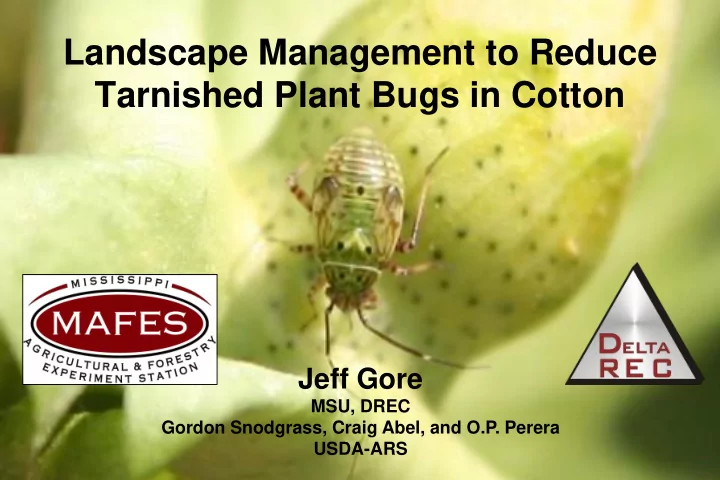

Landscape Management to Reduce Tarnished Plant Bugs in Cotton Jeff Gore MSU, DREC Gordon Snodgrass, Craig Abel, and O.P. Perera USDA-ARS
Seasonal Occurrence of Plant Bugs Cultivated Hosts Reproductive Diapause Break Diapause Wild Hosts Enter Diapause Wild Hosts Wild Hosts Wild Hosts Squaring Flowering Burndown Planting Harvest Winter Spring Summer Fall Dec.-Feb. Feb.-May June-Sept. Sept.-Dec.
Distribution of Tarnished Plant Bugs in the Landscape - May Week 1 Week 2 Week 3 Week 4 Medium Low High
Distribution of Tarnished Plant Bugs in the Landscape - June Week 1 Week 2 Week 3 Week 4 Medium Low High
Distribution of Tarnished Plant Bugs in the Landscape - July Week 1 Week 2 Week 3 Week 4 Medium Low High
Gene Flow Between Populations 2006 O.P. Perera, USDA-ARS 0.62, 2.83, 5.72 0.53, 5.45, 8.43 Key: May, July, September
Tunica/Robinsonville 2007-2008 Clarksdale Leland/Stoneville Rolling Fork/Cary Vicksburg St. Joseph, LA
Dec.-Feb. Winter Reproductive Diapause Break Diapause Wild Hosts Burndown Late Winter and Early Spring Feb.-May Spring Planting Wild Hosts Squaring Flowering Harvest Wild Hosts Cultivated Hosts Wild Hosts Enter Diapause
Examples of early-spring broadleaf hosts of tarnished plant bug Buttercup Annual Evening Butterweed Fleabane Primrose Sourdock Vetch Crimson Clover Cutleaf Primrose
Area-wide Plant Bug Management Gordon Snodgrass, William Scott, and Craig Abel – USDA-ARS One herbicide application from late-Feb. through March.
Area-Wide Plant Bug Control MS Delta 6 Treated 5 No. per 100 sweeps Untreated 4 3 2 1 0 1 2 3 4 1 2 3 4 Week in June Week in July
No. Plant Bug Applications 8 7 Treated 7 Untreated 5.5 6 Average 5 4.2 3.8 4 3.2 3.1 3 1.7 2 0.9 1 0 1999 2000 2001 Average
Economic Benefit 9 $7.81 8 Dollars per Acre 7 $6.46 $5.90 6 5 4 $3.44 3 2 1 0 1999 2000 2001 Average
Area-Wide Plant Bug Control MS Hills 5 4.5 Treated No. per 100 sweeps 4 Untreated 3.5 3 2.5 2 1.5 1 0.5 0 6/6 6/13 6/20 6/27 7/4 7/11 7/18 7/25 Sample Date
Untreated Treated
Treated with Roundup at Burndown
Reproductive Diapause Break Diapause Wild Hosts Burndown Summer (Crop Season) Planting Wild Hosts Squaring June-Sept. Summer Flowering Harvest Wild Hosts Cultivated Hosts Wild Hosts Enter Diapause
Regional Temik Side-Dress Study Missouri – Kelly Tindall Arkansas – Gus Lorenz, Glen Studebaker, and Scott Akin Tennessee – Scott Stewart Mississippi – Jeff Gore, Angus Catchot, Don Cook, and Fred Musser Louisiana – Ralph Bagwell and Roger Leonard
Temik Side Band Applications Non-treated Temik 5 lbs. Temik 8 lbs. 14 11.9 12 No. Nymphs per 6 row ft. 10-31% 9.8 10 8.8 8 6.8 60-80% 6 4.8 4.1 3.9 4 2.3 2 2 0 5 DAT 10 DAT 20 DAT
Fall - Winter (Reproductive Diapause) Cultivated Hosts Reproductive Diapause Break Diapause Wild Hosts Enter Diapause Wild Hosts Wild Hosts Wild Hosts Burndown Planting Squaring Flowering Harvest Winter Fall Dec.-Feb. Sept.-Dec.
Overwintering Habitats • Winter Annuals – Mostly henbit, Lamium amplexicaule • Plant Debris
Percentages of Reproductive Females with Mature Eggs (2002-04) – G. Snodgrass % with Mature Eggs Henbit Plant Debris Mustard Month Wk 0 - 1 30 December 2 59 0 0 75 0 0 3 6 0 4 62 1 75 35 27 January 95 85 93 2 87 83 3 100 4 96 95 92
Occurrence of Nymphs on Winter and Spring Hosts G. Snodgrass, 1999-2001 Henbit Sour Dock Buttercup Shepherdspurse Daisy Fleabane Butterweed 0 1 2 3 4 5 6 7 8 9 10 11 12 13 14 15 16 Jan. Feb. Mar. Apr.
Summary and Conclusions • Host management during the early spring can provide an economic benefit. • Crop arrangement and border management from planting through summer. • Fall and winter management has not been investigated, and may provide some good opportunities.
Summary and Conclusions • Tarnished plant bugs feed and reproduce on over 350 plant species which makes it a difficult challenge. • Because of that, management from a landscape perspective using an integrated approach will yield the greatest success.
Recommend
More recommend